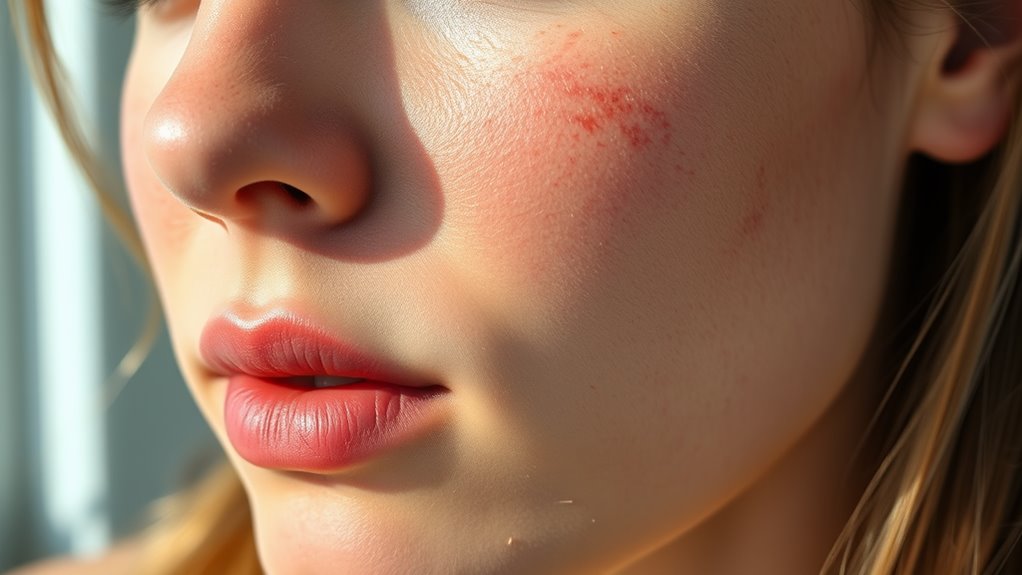Is Your Face Wash Too Harsh. Here’s How to Tell
Did you know that even gentle-seeming face washes can disrupt your skin’s pH balance, leading to unseen damage? If you’re noticing irritation or tightness, it’s time you identify the culprits and switch to safer options—stick around to learn the key signs and fixes.
Key Takeaways
- If your skin stings or feels tight right after washing, it could indicate a harsh face wash.
- Redness, dryness, or itching are key symptoms that your cleanser is too abrasive.
- Check for harmful ingredients like sodium lauryl sulfate, which strips the skin’s barrier.
- Perform a patch test; any redness or discomfort after 24 hours signals irritation.
- If you notice frequent breakouts or flaking, your face wash may be compromising your skin’s protection.
Signs of Skin Irritation From Your Face Wash
How can you tell if your face wash is irritating your skin?
You spot harsh cleanser signs by observing immediate reactions after use.
If your skin feels tight or stings upon application, it’s signaling potential irritation.
Scientifically, these signs arise when formulations strip natural oils, disrupting the barrier.
Practically, perform a patch test on your inner arm first; wait 24 hours for any redness or discomfort.
Avoid products with sulfates or alcohol, as they amplify issues.
Regularly assess your routine to ensure it supports healthy, balanced skin without causing undue stress.
Additionally, overwashing can damage the skin’s natural barrier, making your skin more susceptible to problems like dryness and infections.
Common Symptoms of a Harsh Cleanser
Common symptoms of a harsh cleanser often show as redness, dryness, or itching shortly after use.
You can spot these signs by monitoring your skin’s immediate response, which indicates irritation and potential barrier disruption.
Early recognition helps you adjust your routine effectively.
To paint a clearer picture of these symptoms:
- Redness: Your skin may flush and feel warm, signaling inflammation that compromises its protective layer.
- Dryness: You’ll notice tightness and flaking, as the cleanser strips away essential oils and moisture.
- Itching: A persistent burning sensation might occur, prompting discomfort that signals an adverse reaction.
Act promptly to prevent escalation.
Additionally, frequent breakouts may also signal a deeper issue with your skin’s protective barrier.
Ingredients That May Damage Your Skin
Certain ingredients in face washes can erode your skin’s protective barrier, leading to irritation and long-term damage. You need to scrutinize labels for substances that disrupt your skin’s pH or strip natural oils, such as sulfates and drying alcohols. These can cause inflammation and sensitivity over time.
To help you spot potential issues, here’s a breakdown of harmful ingredients:
| Ingredient | Potential Harm | Why to Avoid |
|---|---|---|
| Sodium Lauryl Sulfate (SLS) | Strips lipids and moisture | Disrupts barrier, causes dryness |
| Alcohol (e.g., ethanol) | Dehydrates and inflames skin | Weakens defenses against irritants |
| Fragrances | Triggers allergies or rashes | Offers no benefits, increases risk |
| Parabens | May disrupt hormones | Linked to long-term sensitivity |
| Synthetic Dyes | Causes contact dermatitis | Unnecessary and potentially irritating |
Recognize these to protect your skin effectively. Additionally, watch out for miracle solutions that are often marketed as quick fixes but can harm your skin barrier and lead to lasting sensitivity issues. (99 words)
How to Choose a Milder Face Wash
When choosing a milder face wash, prioritize products with gentle, pH-balanced formulas that preserve your skin’s natural barrier.
You’ll avoid irritants by selecting sulfate-free options that maintain your skin’s moisture and pH (ideally 4.5-5.5).
This approach minimizes inflammation and supports long-term health.
- Examine labels: Seek non-comedogenic ingredients like glycerin or ceramides to prevent pore clogging while keeping skin hydrated.
- Assess pH levels: Choose washes tested at a neutral pH to match your skin’s acidity, reducing sensitivity.
- Consider skin type: Pick formulations for dry, oily, or combination skin to ensure compatibility without over-drying.
To optimize your routine, incorporate skin type factors from expert recommendations for a personalized approach.
Steps to Repair and Protect Your Skin
After switching to a milder face wash, you’ll repair and protect your skin by following targeted steps that restore its barrier, reduce irritation, and prevent future damage.
First, gently cleanse with a pH-balanced formula to preserve your skin’s acid mantle. Apply a ceramide-rich moisturizer twice daily to strengthen the barrier and lock in hydration. Incorporate antioxidants like vitamin C to combat free radicals. Always use broad-spectrum SPF 30+ sunscreen outdoors. Monitor for redness or dryness, adjusting as needed, and avoid harsh exfoliants.
These steps promote resilience and long-term health. To maximize effectiveness, ensure you apply products in the correct order based on their absorption rates.

